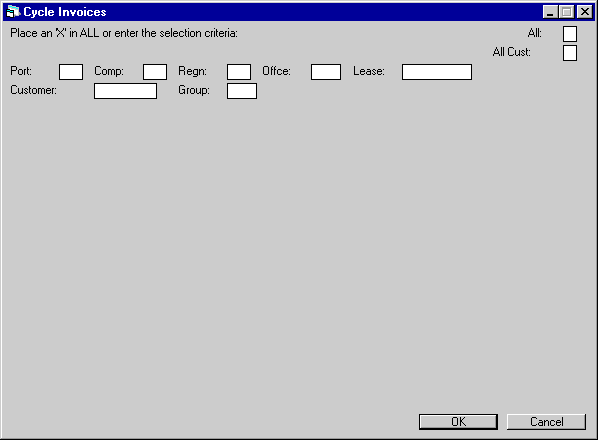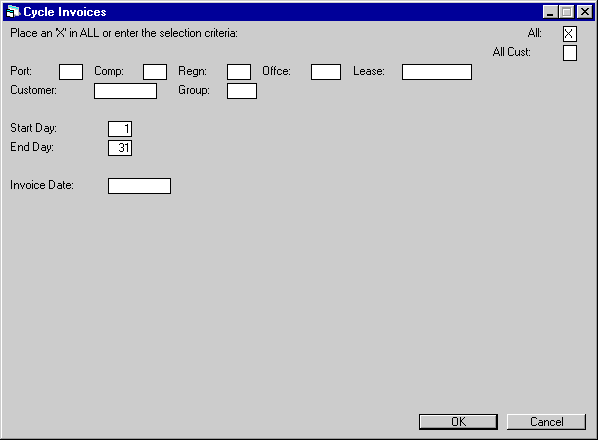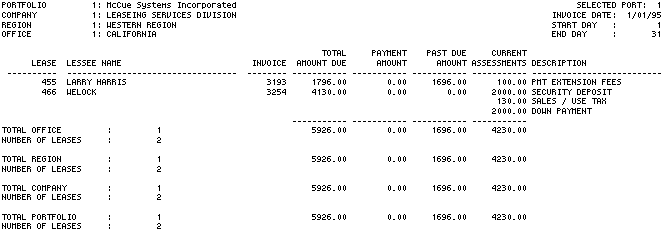The Cycle Invoices update interactively selects and invoices a lease or a selection of leases. This interactive update is intended to allow the user to produce an invoice for an individual lease. For example, when a newly booked lease is back dated and payments are already due, the user who booked the lease may want to create an invoice immediately. Another example is producing a copy of an invoice lost in the mail. There is the option to invoice for a selection of leases or for all leases in the entire LeasePak system.
When the Off Lease Billing module is purchased and an assessment has been added via the Assessment [U0105] update to a paid-off or terminated lease/asset, an invoice will be created and due in 30 days from the date entered.
The Cycle Invoices update is normally automatically run during the End of Period process [U04] according to predefined cycles. These cycles are specified through the Predefined Cycles Customizations option of the Portfolio update [U0212].
Cycle Invoices may also be performed interactively, without affecting the normal End of Period operation. The update can be accessed through the LeasePak Update menu, Predefined Cycle option or by entering U0302 into the Fast Menu <F2>.
The invoicing process performs the following functions:
Note: If a credit memo is applied to a lease extended using the RES method on a cash basis, additional G/L transactions occur which actually recognize the income and/or residual that was deferred during accruals. Refer to the Accrual Methods section in the LeasePak Calculations document for more information on this accrual method.
The following reports are produced by the Cycle Invoices update [U0302]:
Normal invoicing for the portfolio is performed during the End of Period process,
according to an invoicing cycle specified through the Predefined
Cycles Customizations option of the Portfolio update [U0212].
Leases that are pre-booked, i.e., leases booked with a commencement date in the future, are not invoiced until one month before their commencement date. An accounts receivable record is established at the time of booking, but it is not processed until the invoice is to be sent out.
Related leases may be consolidated and billed on a single invoice or group bill. This group bill is printed on regular 8 1/2 by 11 inch paper, instead of the formatted mailer of the individual invoices. Therefore, much more information can be printed on the bill. This is useful for lessees which may require more information.
To activate group billing, customer and group designations must be established for the leases. The customer information is set up through the Customer update [U0205] and group information through the Group update [U0209]. Leases may then be attached to the appropriate group, either
through the Group update [U0209] or when the leases are booked through the Book Lease option of the New Lease update [U0101]. Group billing is activated as soon as a lease is attached to a group.
There may be up to 999 groups for each customer. The customer address functions as the billing address. Therefore, if one customer requires several different consolidated bills, a customer number should be established for each billing address and groups added for each customer. Leases should then be attached to the appropriate groups.
Invoice processing involves 2 stages.
The first stage includes lease selection and necessary file updating by the invoicing process. Information to be printed on the invoice is assembled and written to an output scratch file for the actual formatting of invoices in the second stage. The invoice scratch file may be generated from the LeasePak interactive function [U0302] or from execution of an End of Day. The name and location of the scratch file depend on how the scratch file was created. If the file was created from [U0302], the name of the scratch file will be LPU0302A.SCR and the file will be in the default directory of the user who generated the invoices. If the scratch file was created from an End of Period process (such as End of Day), the scratch file created will be EOP:Pxx__LPU0302A.SCR where EOP: is the logical name for the End of Period directory, and xx is the portfolio number for the End of Period (Example: EOP:P1__LPU0302A.SCR). Thus, there will be an invoice scratch file for each portfolio for which an End of Day is executed.
The second stage uses the file(s) created during the first stage to produce formatted invoices.
This 2-staged approach allows greater customization of invoices:
The output file(s) created by the first stage of the invoicing process contain a number of informational items for each invoice that may be used to customize the invoice. These items are:
Contact a client services representative at MSI for more information on developing a custom formatting program.

This screen is used to select the lease or selection of leases to invoice.

This screen is used to enter the range of payment due days to invoice and the date to be printed on the invoice as Invoice Date.
The values in the START DAY and END DAY fields are initially defaulted to include all possible payment due days (1 through 31), but may be changed to produce a narrower range. If only leases with a particular payment due date are to be invoiced, both START DAY and END DAY may be set to the same value.

The Individual Invoice Billing Register [U0302C] reports at the lease level and provides the following invoice information for each individual lease invoiced:
Note: If the SORT INVOICES BY CUSTOMER parameter on the first screen of the Miscellaneous Customizations option of the Portfolio update [U0212] is set to Y, the Individual Invoice Billing Register report [U0302B] lists invoices for leases tied to customers sorted by customer and shows the customer totals.

The Group Invoice Billing Register report [U0302E] reports at the group level and provides the following invoice information for each group invoiced:

The Cycle Invoices Exception report [U0302A] reports at the group and individual lease level and provides messages for each group and/or individual lease that failed to invoice:
ACCRUAL
SYSTEM RECORD DOES NOT EXIST
This message indicates that no record exists
for this lease or group on the Accrual system (RAS) file. It indicates a data
error. Notify your client services representative at MSI.
ADDRESS
RECORD DOES NOT EXIST
This message indicates that no record exists for this
lease or group on the Lessee (RAL) file. It indicates a data error. Notify your
client services representative at MSI.
APPLIED
CREDIT MEMO CANNOT BE UPDATED
A credit memo which was applied could not be
updated. This message indicates a data error. Notify your client services representative
at MSI.
APPLIED
TAX CANNOT BE UPDATED
The sales tax amount on the invoice does not match the
sales tax amount on the tax payable file. This message indicates a data error.
Notify your client services representative at MSI.
DEMOGRAPHIC
RECORD DOES NOT EXIST
This message indicates that no record exists for this
lease or group on the Demographic (RDM) file. It indicates a data error. Notify
your client services representative at MSI.
WARNING:
RAR/RTP TAX BILL/ASSESS AMTS DO NOT AGREE
(Accrual based accounting only):
This message indicates that the tax amount billed on the A/R file (RAR) does not
agree with total amount of tax assessed on the Tax Payable file (RTP). This might
indicate that an asset payoff was performed for this lease, and the additional
tax from the payoff has updated the tax assessed/paid on the Tax Payable file
(and the A/R file would not be updated). Or this message might indicate that there
is corruption in the RTP or RAR file, and the itemized tax due in the Invoice
scratch file (LPU0302A.SCR) may not be accurate. Further research is necessary
to determine if this situation is valid or indicates a form of data corruption.
Note - if the itemized tax due (i.e. State, County, and City) is not detailed
on the formatted invoice, then this warning message may be ignored.
TAX
PAYABLE (RTP) RECORDS DO NOT AGREE WITH A/R RECORD (STAX)
This message indicates
that the city, county, and state tax assessment amounts on the Tax Payable (RTP)
records do not equal the amount of the total use tax assessment on the A/R (RAR)
record.
ERROR
ON RTP RECORD GETTING USE TAX DATA
This message indicates that no use tax
record exists in the RTP file for this invoice.
INVOICE
RECORD IS LOCKED
This message indicates that a record for the group or lease
on the Invoice (RAR) file is locked. Try executing the Cycle Invoice update [U0302]
for this lease or group again. This message should not appear if executing through
End of Period.
NO
EXCEPTIONS FOUND
This message indicates that no errors were detected. The
Cycle Invoices update [U0302] executed properly for all selected leases.
NO
ASSETS BELONG TO THIS LEASE
This lease does not have any assets associated
with it. This message indicates a data error. Notify your client services representative
at MSI.
NUMBER
OF CHARGES PER LEASE LIMIT EXCEEDED
The invoicing limit maximum is 120 charges
(payments and assessments) per lease. This message indicates that the maximum
for this lease is exceeded. It is necessary to make payments for this lease to
reduce the number of outstanding charges.
NUMBER
OF INVOICES PER LEASE LIMIT EXCEEDED
The invoicing limit maximum is 120 invoices
and credit memos per lease. This message indicates that the maximum for this lease
is exceeded. It is necessary to make payments for this lease to reduce the number
of outstanding invoices.
NUMBER
OF LEASES PER GROUP LIMIT EXCEEDED
The invoicing limit maximum is 300 leases
per group. This message indicates that the maximum for this lease is exceeded.
Add another group with the same characteristics as the existing group using the
Group update [U0209], and then add the leases to the new group.
NUMBER
OF ASSETS PER LEASE LIMIT EXCEEDED
The invoicing limit maximum is 100 assets
per lease. This message indicates that the maximum for this lease is exceeded.
Book another lease with the same characteristics as the existing lease using the
New Lease update [U0101], and then add the assets to the new lease.
REMITTANCE
ADDRESS RECORD DOES NOT EXIST
This message indicates that no record exists
for this lease or group on the Remittance Address (RNA) file. Add the remittance
address record through the Auxiliary Address update [U0704].
REMITTANCE
ADDRESS LIMIT EXCEEDED
The invoicing process has a limit of 99 remittance
addresses. This message indicates that more than 99 remittance addresses exist.
Reduce the number of remittance addresses used through the Remittance Address
option of the Auxiliary Address update [U0704].
TAX
PAYABLE RECORD IS LOCKED
This message indicates that a record for the group
or lease on the Tax payable (RTP) file is locked. Try executing the Cycle Invoice
update [U0302] for this lease or group again. This message should not appear if
executing through End of Period.
TAX
RELEASED RECORD IS LOCKED
This message indicates that a record for the group
or lease on the Tax released (RTR) file is locked. Try executing the Cycle Invoice
update [U0302] for this lease or group again. This message should not appear if
executing through End of Period.
TRANSACTION
IS IN PROGRESS
This message appears during interactive processing. It indicates
that the End of Period process [U04] is already submitted for the portfolio. During
the End of Period process [U04] the updates for the portfolio are locked. This
message should not appear if executing through End of Period.
UNKNOWN
TRANSACTION TYPE xxxx
An invoice for this lease contains an invalid assessment
type, where xxxx represents the assessment type. This message indicates a data
error. Notify your client services representative at MSI.
VENDOR
RECORD DOES NOT EXIST
This message indicates that no record exists for this
lease or group on the Vendor (RLR) file. Add the vendor record through the Vendor
update [U0201].
LeasePak Reference Guide
©
by McCue Systems Incorporated. All rights reserved.
The information contained in this document is the property of McCue Systems, Inc. Use of the information contained herein is restricted. Conditions of use are subject to change without notice. McCue Systems, Inc. assumes no liability for any inaccuracy that may appear in this document; the contents of this document do not constitute a promise or warranty. The software described in this document is furnished under license and may be used or copied only in accordance with the terms of said license. Unauthorized use, alteration, or reproduction of this document without the written consent of McCue Systems, Inc. is prohibited.